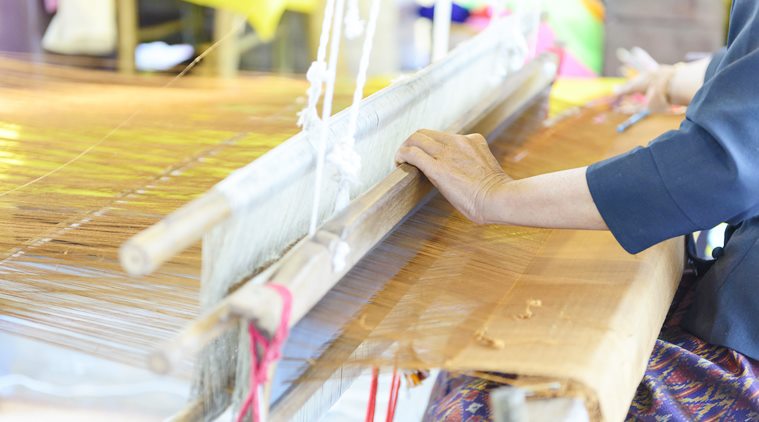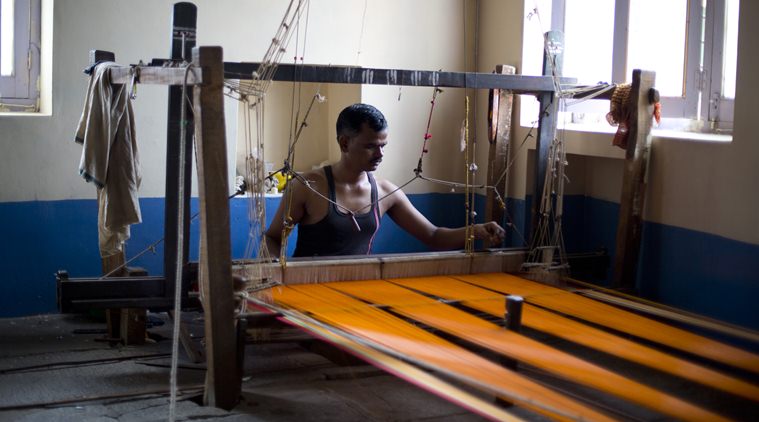 India’s soft power has been long endorsed by the handloom and handicraft . space, in addition to other symbols of cultural power in the field of arts and crafts(Photo: Getty Images/Thinkstock)
India’s soft power has been long endorsed by the handloom and handicraft . space, in addition to other symbols of cultural power in the field of arts and crafts(Photo: Getty Images/Thinkstock)
The Government of India has been celebrating the National Handloom Day on August 7 since 2015, when it commemorated the 100th anniversary of the Swadeshi Movement, which began in 1905. National Handloom Day celebrates the contribution of artisans and weavers to the rich cultural capital of the country.
From the plain looms to the post-loom decorated works that include sarees, shawls, scarves, dhurries, carpets, towels, angocha/gamcha, traditional ‘angavastrams’, dress materials, the textiles and handloom sector in India is the second-largest source of employment to people, after agriculture. According to the Fourth All India Handloom Census, 31.45 lakh households are engaged in handloom, weaving and allied activities.
On National Handloom Day, we salute all those associated with our vibrant handloom and handicrafts sector. They have made commendable efforts to preserve the indigenous crafts of our nation. Let us all be #Vocal4Handmade and strengthen efforts towards an Aatmanirbhar Bharat. pic.twitter.com/XD7cs9ES7F
— Narendra Modi (@narendramodi) August 7, 2020
The handloom sector, self-help groups (SHGs) and COVID-19
It is for this contribution, that in times of COVID-19, the Indian handloom and handicraft space merits more attention. Soon after the lockdown, telling stories began to emerge of how the artisans employed with the sector were in need of an imminent policy impetus to safeguard the livelihoods of artisans and weavers. Traditionally, the months between January until June see a host of rural exhibitions, haats, bazaars that witness the participation of weavers and artisans from across the country, everywhere. This is also the time for maximum visibility, sales, and exposure. Places like Dilli Haat, Dastkar and emporiums at the Baba Kharak Singh Marg in Delhi usually throb with activity. However, with the lockdown, norms of social distancing, and sudden economic turbulence, no such fervent exhibitions or markets could be witnessed. Additionally, natural calamities such as the recent Assam floods further impacted the livelihoods of artisans, especially in the silk clusters of the state.
COVID-19 together with such uncertainties has produced livelihood shocks to artisans and weavers impacting incomes and the entire supply chains involved in handloom and handicraft, along with supplies of raw materials and unused inventory. For instance, according to the Tribal Cooperative Marketing Development Federation of India (TRIFED), tribal handicraft and handloom worth ₹100 crore went unsold owing to the lockdown, according to the Down to Earth (2020).
Amid this, however, the latent potential of the vast network of self-help groups (SHGs), artisans, and weavers employed in the sector rose to the occasion during the lockdown. The vast network of SHGs engages in making handloom and crafts and contributes immensely to rural development, the village economy, since the inception of government programmes like the National Rural Livelihoods Mission (NRLM). With the help of state and district administrations, artisans and members of SHGs were roped in to manufacture masks. According to an article on the World Bank site dated April 11, 2020, more than 19 million masks were made by 20,000 SHGs across 27 Indian states.
Soon after handloom and artisanal Madhubani, Ikkat, Cheriyal, painting masks, to name a few, came into the fray, highlighting how the state administrations were working toward generating incomes harnessing the creative talents of the vast network of artists.
 Handloom weaver seen working on an ilkal sari. (Express photo by Jyothy Karat)
Handloom weaver seen working on an ilkal sari. (Express photo by Jyothy Karat)
The textile clusters employing scores of artisans should be, therefore, further encouraged in making masks and other medical equipment that uses textiles such as bedsheets, etc. contributing to the medical infrastructure, in whichever capacity possible. For instance, according to the Fourth All India Handloom Census (2019-2020), some products that also include surgical bandages are produced by nearly 4.3 percent of handloom worker households
However, these must be practiced with caution as Indian handlooms need conservation as the sector is mired with issues of cheap emulations, automated looms that threaten the sustenance of original arts of warp and weft involved in traditional weaving – which the weavers are experts at since generations. Automation of the handloom sector, therefore, threatens the survival of these timeless skills, the reason why the sector needs more governmental support and encouragement.
Cultural diplomacy, vocal for local
India’s soft power has long been endorsed by the handloom and handicraft space, in addition to other symbols of cultural power in the field of arts and crafts. Saree diplomacy and ‘Khadi diplomacy’ are some such examples furthered by the Indian government on various platforms. The basic idea is to promote the finesse of Indian weavers on the global map to communicate, disseminate and engage with not just the global audience but the Indian diaspora through these symbols of cultural expression. The importance of cotton and textiles, for example, is highlighted since the days of Indus Valley Civilisation. History has it that in foreign trade back in the days of the East India Company, the Indian muslin and cotton were of finest varieties, and were used a great deal to reap profits by the colonialists.
The government’s ‘Atmanirbharta’ programme, the ‘vocal for local’ campaign, together with ‘Make in India’, presents a huge opportunity to the handloom sector to further strengthen the Indian positioning in the global textiles space. In order to boost this, however, the demand first has to come from home. While the impact and initial shocks of COVID-19 have had an initial calamitous impact on poor rural and urban livelihoods, the opportunities are immense. Toward this, all stakeholders including the private sector must come forward.
For instance, in Odisha women SHGs engaged in crafting cotton and ‘Sabai’ grass Rakhis with the help of Odisha Rural Development and Marketing Society. A similar such initiative called ‘Ummed ki Rakhi’ was launched by the New Delhi district administration under the aegis of which SHGs were formed to provide employment to women from urban slums. Similarly, corporate organisations must buy products from artisans for the purposes of awards, corporate engagement programmes, and business gifting. This shall facilitate direct producer-consumer interface, thereby ensuring proper returns on the products to artisans. Additionally, encouraging SHGs to promote handloom-styled masks and accessories that have the Geographical Indications (GI) should be undertaken with adequate quality checks for international markets.
Way forward
Initiatives such as the Northeast Expo 2019 under the aegis of ‘tea and khadi’ diplomacy must be continued digitally. The initative provided a platform to the eight northeastern states through ‘Tea and Khadi’ diplomacy furthering trade ties with the ASEAN and BIMSTEC nations. Since physical markets shall still take a while to operate fully, this is a good moment for states and the Centre to have more and more online market portals for Indian handlooms, handicrafts, and forest produce — as the sectors are interlinked.
Additionally, it also provides an opportunity for the sector to train SHG members in online skills — a first from the traditional financial literacy and marketing initiatives in capacity building. While the markets move online, it is equally important for the artisans to get adequately equipped and trained in operating online portals. Online exhibitions through Indian embassies must be organised to make the global audience aware of the rich legacy of handlooms. Just before the lockdown in fact, in the UK, an exhibition under the aegis “Forgotten Masters: Indian Painting for the East India Company”, was organised in order to honour and remember painters from India.